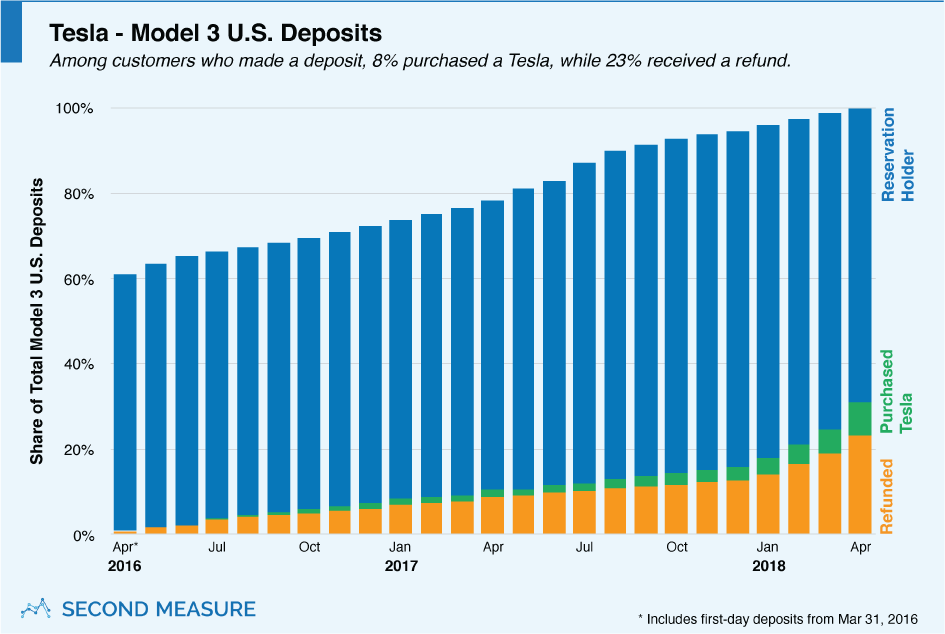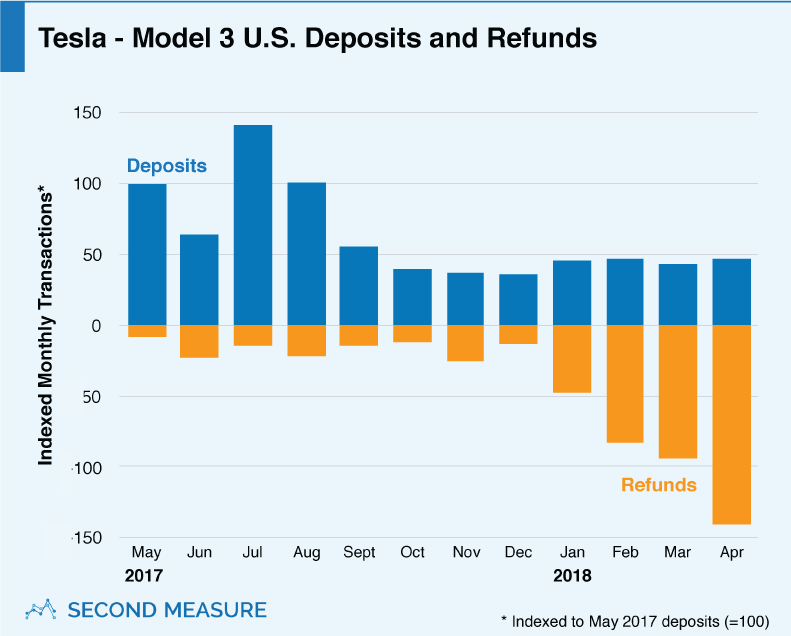NOTE: Bloomberg Second Measure launched a new and exclusive transaction dataset in July 2022. Our data continues to be broadly representative of U.S. consumers. As a result of this panel change, however, we recommend using only the latest posts in assessing metrics, and do not support referring to historical blog posts to infer period-over-period comparisons.
Tesla began accepting deposits for the Model 3 more than two years ago and, after several delays, production is finally ramping up. But those holding out for the baseline Model 3—priced at $35,000—have just been told they’ll need to keep waiting. Refunded deposits have already been on the rise, and the latest news could push additional reservation holders to request their money back.
Model 3 deposits are fully refundable up until the customer configures a car by selecting features and paying an additional fee of $2,500. After configuration, vehicles are typically delivered in just a few weeks. As of April, 8 percent of U.S. Model 3 depositors had configured a Tesla for production, while nearly a quarter of deposits had been refunded. The remaining two-thirds are in limbo—either still holding a spot in the Model 3 queue or waiting for a requested refund to be processed.

Deposits started off strong. On March 31, 2016, eager early adopters drove a surge of initial deposits, and 61 percent of all Model 3 reservations occured in the first month. In August 2017, Tesla disclosed the gross and net Model 3 reservations, revealing a refund rate of 12 percent. Our analysis aligns with Tesla’s reported figures, also finding that 12 percent of deposits had been refunded at that time.
Extended wait times cause refunds to rise
More recently, Tesla has been tight-lipped about its current rate of refunds. Investors have good reason to be interested—as of last quarter, more than a third of Tesla’s cash holdings were customer deposits, which includes reservations for new Teslas other than the Model 3. Tesla is presently paying out refunds faster than new Model 3 deposits are coming in and, so far in 2018, it has issued twice as many $1,000 refunds as it has received $1,000 deposits.

The Model 3 faced a series of production delays, and not all depositors have stuck out the wait. Since reservations began, 23 percent of deposits have been refunded. Only Tesla knows how many additional customers have cancelled reservations and are still awaiting refunds.
Meanwhile, monthly new reservations have remained level in recent months. With Model 3 wait times currently advertised as 4-12 months, potential buyers joining the bottom of the queue may be unwilling to purchase if they find themselves ineligible for major federal tax credits, expected to start phasing out this year.
More Model 3 depositors are finally configuring orders
Earlier this month, Elon Musk came under fire for skirting questions during the Tesla Q1 earnings call, declining to disclose how many Model 3 reservations have gone on to be configured for purchase. Like refunds, our analysis shows configurations are also on the rise. In April, the number of configurations nearly tripled month-over-month among Model 3 reservation holders. These findings may exclude some customers who used different payment methods for the deposit and configuration.
A rising rate of configurations sounds like a happy ending for Tesla fans, but this story has a twist—configurations aren’t necessarily for Model 3s. Some impatient reservation holders are purchasing a more expensive Tesla instead. The Model S and X each start at double the price of a baseline Model 3, making the upsell an ideal outcome for Tesla.
Will the remaining Model 3 deposits lead to refunds or sales? Get in touch to keep up with the latest Tesla data.
Oh, and we’re hiring.
